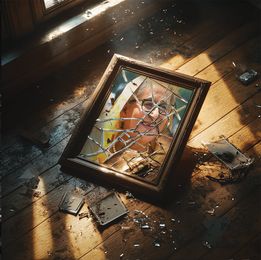Every revolution has a defining moment. The Yanks had it when they hurled tea chests into the Boston Bay. The French had it when they stormed the Bastille. The Bolsheviks had it when battleship Aurora fired blank shots at the Winter Palace in St Petersburg.
Revolutions, these days, have their defining moments when icons fall in town squares, or mobs invade palaces of the powerful. We saw it in Budapest in 1956, in several east European and central Asian capitals in the 1990s, in Cairo, Tripoli and Baghdad in the new century, and in Colombo two years ago. Last Monday, we saw it in Dhaka.
This time, however, few of us rejoiced; rather, many shed a tear. Not for the icon that fell in the town square, or for his politically misguided daughter who abused her power and wasted the democratic dividend that had been bestowed on her. We shed a tear for Bangladesh, a nation we had helped create.
The father and daughter offer a study on how democracies can elect dictators. Sheikh Mujibur Rahman was the toast of the liberal democratic world in the 1970s when he transformed a simple mother-tongue demand into an agitation seeking political liberties from a jackbooted regime, and finally metamorphosed it into a revolution seeking a representative government. Yes, the movement that ended up in the creation of sovereign Bangladesh had begun as a protest against the imposition of Urdu over Bengali. It turned into a political strife after protesters in the east were shot dead on February 21, 1952. (In 1999 the UNESCO adopted February 21 as the International Mother Language Day.)
Within months of coming to rule the newly created eastern republic, Mujib fouled up the economy that got crippled by a famine, curtailed civil liberties, imposed one-party rule, turned into an autocrat, and fostered a personality cult around him. Finally, a few colonels and captains shot him.
The daughter made the same mistake. Coming to power after years of exile and persecution, she unleashed a reign of revenge, hanging her father’s enemies, hounding the wise men, and jailing her critics. The economy grew fast, but she gave out few jobs which she sought to keep for the kin of her father’s fighters. Now destiny has caught up with her, too.
Why did India escape such turmoils? For one, we won our freedom without shedding blood. We had realised the futility of military violence in 1857 and of mob fury at Chauri Chaura in 1922, and since then explored the path of persuasion and petitioning first, peaceful non-cooperation next, and civil disobedience afterwards. When sent to jail, we went to jail; when the jails got crowded, they let us go.
Finally, this week 77 years ago, they let us all free; and we let them go in peace.
Neither on the dawn of freedom nor later, did we do violence even to their icons. Colonial statues, that had stood in town squares as in R.K. Laxman’s introductory graphic in his brother’s Malgudi Days tele-play, were taken off over the years with neither violence nor fanfare, and quietly moved into museums or art houses. Many that stood in the myriad roundabouts of imperial New Delhi have been re-erected in a picturesque park on the crowded city’s outskirts. You can see George V, who had stood in the canopy near India Gate, and four of his viceroys still standing in the Coronation Park where he had held the empire’s third and last durbar, and from where he had decreed a new capital.
Our founding fathers taught us to be kind to our foes and to those who disagree with us. Let that spirit of non-violence prevail. Happy Independence Day!
prasannan@theweek.in


